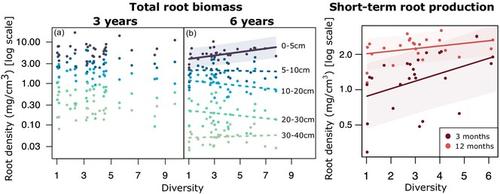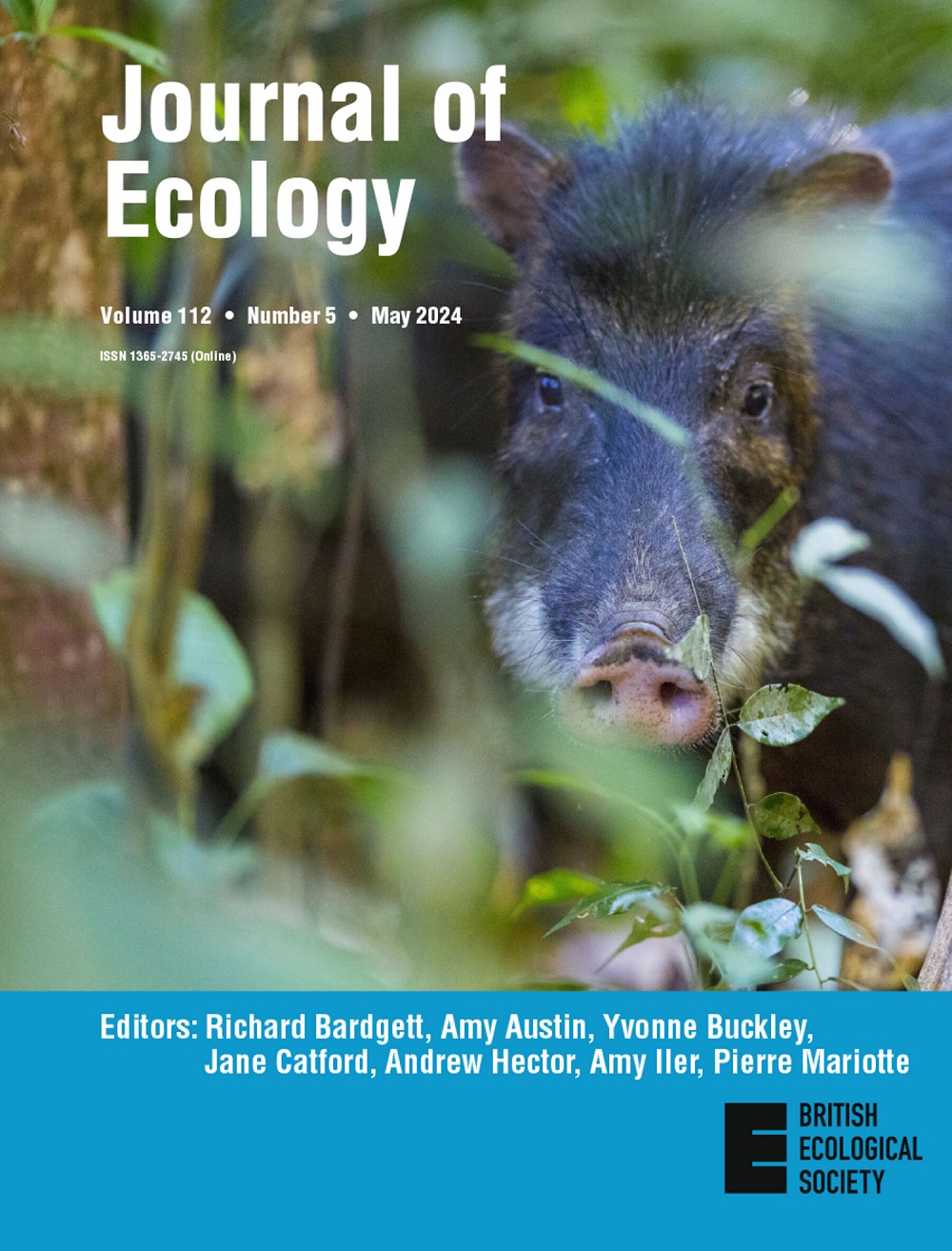Plant diversity loss has limited effects on below-ground biomass and traits but alters community short-term root production in a species-rich grassland
IF 5.3
1区 环境科学与生态学
Q1 ECOLOGY
引用次数: 0
Abstract


在物种丰富的草地上,植物多样性丧失对地下生物量和性状的影响有限,但改变了群落短期根系产量
生物多样性和生态系统功能之间的相互作用是生态学中一个长期存在的核心问题。生物多样性-生态系统功能(BEF)实验表明,生物多样性与生产力之间存在正相关关系。互补效应是对不同群落生态系统功能增强的一种解释(Cardinale et al., 2007;Loreau,赫克托耳,2001;Tilman et al., 2001)。这种效应源于这样一个事实,即在更多样化的群落中,物种策略的变化有望优化资源利用,从而提高生产力。虽然互补效应可以由多种机制引起,但在植物中,它们通常与水平(von Felten &;Schmid, 2008)或垂直生态位分化(Li et al., 2018),特别是在地下,在不同的植物群落中,根的分布预计会表现出更多的变异性(Brassard et al., 2013)。另一种解释实验性BEF正相关的机制是选择效应,即随着物种数量的增加,一个高功能物种出现在一个物种组合中的可能性会增加(Cardinale et al., 2011)。在过去的几十年里,关于生物多样性丧失对自然群落生态系统功能的影响,BEF实验的结果是否能提供见解一直存在争论(Doherty &;Zedler, 2018;地蜡š,2004;瓦尔德,2016)。大多数BEF实验依赖于从物种库中随机选择的物种,这通常不能代表可以模拟物种损失的现实群落。虽然这样的实验设计提供了可控的模拟,可以提供重要的机制信息(Eisenhauer等人,2016),但它们在某些方面可能会产生误导,因为自然物种的丧失并不是一个随机过程(Schläpfer等人,2005;Schmid et al., 2002)。事实上,一个物种从群落中消失的可能性取决于多种因素,但主要取决于其相对丰度(Genung et al., 2020;史密斯,克纳普,2003;Spehn et al., 2005)。此外,大多数BEF实验都是基于均匀播种的群落,其中所有物种最初播种的丰度相同,这无法代表控制装配过程的环境过滤器和生物因素(Diaz et al., 2003)。另一方面,自然群落的去除实验提供了一个有希望的替代方法。在物种丧失的现实情景下,研究表明,少数优势物种可以补偿稀有和从属物种的消失,并减轻多样性丧失对生产力的影响(Lisner et al., 2023;Sasaki et al., 2017;佐佐木,Lauenroth, 2011;史密斯,Knapp, 2003),进一步质疑传统BEF实验对现实世界社区的可转移性。尽管迄今为止大多数BEF实验都集中在地上生产力(Cardinale等人,2007年),但也有一些研究探索了其他生态系统功能(Spehn等人,2005年;van der Plas, 2019),包括地下生产力。然而,后者主要采用与人工群落相同的传统实验设置(Mueller et al., 2013;Oram et al., 2018;Ravenek et al., 2014)一致显示物种丰富度与根系生物量呈正相关关系。在自然群落中,一些观察性研究也发现了这种关系(Mommer et al., 2010;Zeng et al., 2020),但其他人反驳了物种丰富度对根系生物量有影响的观点(Archambault et al., 2019;Meinen et al., 2009)。地上生物量获得的结果是否会转移到地下生物量仍然是一个悬而未决的问题,因为由于对资源的更对称的竞争,地下可以预期高度的物种互补性(Lamb et al., 2009)。此外,由于物种和年份之间的生物量分配差异很大,物种地上生物量可能与地下生物量不相关(Ottaviani et al., 2020)。为了解决与地下植物特征相关的BEF理论中的各种知识空白,我们的研究考察了现实中的植物多样性丧失对地下功能的影响。通过对半自然草地的迁移实验,根据观察到的优势结构,建立了物种丰富度梯度。这种方法可以模拟更现实的物种损失情景,整合自然群落固有的环境和生物因素。我们比较了3年和6年物种消失后地上和地下生物量沿多样性梯度的变化。测定了不同土层的根系特征。 最后,利用长生岩心测定各样地春季(3个月)和年根系产量。将我们的结果与使用人工群落的经典BEF实验结果进行比较,将有助于我们检验以前评估物种丧失对自然生态系统影响的工作的可靠性。我们的研究旨在回答以下问题:短期根系产量和长期根系生物量是否随着物种的消失而减少?对根系的垂直分布有影响吗?他们的特点呢?我们推测,由于互补效应的丧失和种间相互作用的减少,物种损失可能导致根生物量的减少和细根垂直分布的改变。对于根系性状,在群落水平上测量,我们也期望性状值与较低的获得率相关,更重要的是,与下级和稀有物种的损失相关的性状变异性较低。此外,我们预计多样性较高的样地将更快地定植有效土壤空间,并且在长生核心具有更高的根系产量,特别是在短期内。
本文章由计算机程序翻译,如有差异,请以英文原文为准。
求助全文
约1分钟内获得全文
求助全文
来源期刊

Journal of Ecology
环境科学-生态学
CiteScore
10.90
自引率
5.50%
发文量
207
审稿时长
3.0 months
期刊介绍:
Journal of Ecology publishes original research papers on all aspects of the ecology of plants (including algae), in both aquatic and terrestrial ecosystems. We do not publish papers concerned solely with cultivated plants and agricultural ecosystems. Studies of plant communities, populations or individual species are accepted, as well as studies of the interactions between plants and animals, fungi or bacteria, providing they focus on the ecology of the plants.
We aim to bring important work using any ecological approach (including molecular techniques) to a wide international audience and therefore only publish papers with strong and ecological messages that advance our understanding of ecological principles.
 求助内容:
求助内容: 应助结果提醒方式:
应助结果提醒方式:


